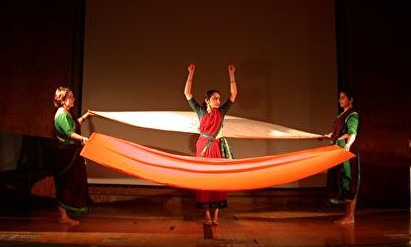|
|
Dance theatre strikes an emotive chord on the Narmada issue.

November 2001: Aparna Sindhoor's dance company performed the dance theatrical, River Rites, at Carnegie Mellon University in Pittsburgh on November 2nd. In addition to Pittsburgh, River Rites has been performed in Boston, Madison, North Carolina and Minnesota. The performance, which was attended by an audience of approximately 100 people in Pittsburgh, is a dance, music and reading recital set amidst the struggle of indigenous communities in the Narmada Valley, with emphasis on the role of tribal women in that struggle.
The story has two main characters - Anand, a city-bred engineer working at the dam site, and Devi, a tribal woman fighting for her right to use the river and the forests around it. Anand discovers the injustices being perpetuated in the Valley, with false promises of rehabilitation. He tries to look for official documentation on the rehabilitation policy, but is continuously thwarted by an apathetic bureaucracy. Devi has fished in the river all her life, till the day she is told that the river is "owned" by the sahibs. She starts to fish at night, but is accused of stealing and is tracked down by the police. Finally, both come together in a final Satyagraha scene, singing songs with hands tied together as the water from the dam rises around them. Following the performance, Aparna answered questions from the audience on the dance form and the dam.

![]() A defiant Devi braves the rising waters of the Narmada
A defiant Devi braves the rising waters of the Narmada
River Rites goes beyond being a Bharatanatyam performance, improvising extensively using narrative, folk dance and yoga. Aparna borrows songs from the struggle, talks both with the narrator and the audience, and uses props to dramatize the events. In doing so, Aparna is one of few artists who uses her background in traditional dance to work actively for social change. She says she was inspired by folk theatre. Many folk songs talk about mythology and other traditional themes, but also relate closely with social issues. Classical dance shouldn't just be about jewelry and costumes, but also embrace deeper issues.
One such deeper issue is the loss of unique languages, customs, art and literature. "You cannot look this up - QA 76.9" say the dancers, referring to the library catalogs that organize most of Western art and music. Once the dam and other large development projects displace indigenous people, they break the ties that preserved and developed that heritage. These are impossible to put together again, and society loses out in richness and diversity, in addition to causing suffering to lakhs of people.
The art is evocative, and inherent in all free societies is the notion that so is justice for the most deprived. Aparna and her fellow-artistes clearly capture that parallel.
Tarun Jain
November 2001
For more information on Aparna Sindhoor and the Navarasa Dance Academy, please visit www.navarasa.org.